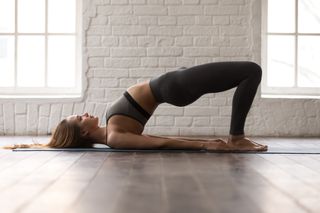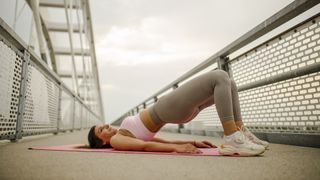Want to recruit your glutes? This is the exercise you need
When you purchase through links on our site, we may earn an affiliate commission.Here’s how it works.
(Image credit: Getty Images)

(Image credit: Getty Images)
Jump to category:How toThe results
Jump to category:How toThe results
Thanks to the likes of J.Lo, Beyonce, and anyone else with a bootylicious butt, the humble glute bridge has enjoyed something of a resurgence in recent years – particularly with female gym goers wanting more junk in their trunks. But the simple fact is that there are so many other reasons to perform glute bridges regularly, aside from toning your tush.
As the biggest muscle in the body, the glutes are responsible for many of the movements we perform daily, from walking and running to sitting down and standing up, so it’s crucial to keep them strong, especially as we get older. In addition, a strong set of glutes can help to protect you from pain in the back, hips, and knees and will massively improve your sporting performance.
Sadly, I have long been cursed (like so many others) with lazy glutes from years of sitting on my butt for entire working days. The result of this Dormant Bottom Syndrome, or DBS (yes, it’s an actual condition, and thatisits real name), means my body is stronger in the anterior chain (the muscles at the front of the body) as opposed to the posterior chain (the muscles at the back). And that means my hip flexors and quadriceps take over when I’m walking, running, or working out.
In short, I can do all the squats in the world, but unless I make an extraordinary effort to focus on my glutes - or activate them before I start exercising - they don’t really get a look in, which equals a not-so-peachy posterior for me. So how could I overcome my DBS and get my glutes firing on all cylinders? Why, with a fitness challenge, of course! Here’s what happened when I did 100 glute bridges a day for an entire month.
How to do glute bridges
There are many versions of the glute bridge exercise, including a single-leg variety and alternatives that usedumbbells,weight plates,barbellsandresistance bands. However, before you progress on to any of those adaptations, it is essential that you nail the basic bodyweight glute bridge first to perfect your form and avoid injury (if you have back issues, seek advice from a medical professional before attempting this move).
What are the benefits of glute bridges?
As you’d expect from an exercise called a ‘glute bridge’, this simple move primarily works the glutes. Comprising of the gluteus maximus (the largest muscle of the body), the gluteus medius, and the gluteus minimus, these muscles work together to move the hip joint, rotate the legs in and out, and stabilise the pelvis when we walk, run, or balance on one leg.
The benefits of strong glutes include better balance and stability through the entire leg to boost multi-directional movement, as well as improved posture to help you stand tall, and greater protection from pain in the back, hips and knees. Moreover, the glutes allow you to power through multi-joint compound exercises such as squats and lunges so you can train more efficiently and help you to be more explosive during acceleration and plyometric jumping movements.
Sign up to the T3 newsletter for smarter living straight to your inbox
Get all the latest news, reviews, deals and buying guides on gorgeous tech, home and active products from the T3 experts
(Image credit: Getty Images)

(Image credit: Getty Images)
Therefore, having a strong set of glutes is crucial for optimising basic movements like walking, running, climbing a flight of stairs, picking something off the floor, and boosting athletic performance when running, weightlifting, or playing sports. Unfortunately,studiesshow that the gluteus maximus is prone to weakness which can contribute to injury, muscle imbalances, chronic pain, and athletic under-performance, so taking care of them is necessary.
Interestingly, while everyday movements and exercises like walking, running, squats and lunges work the glutes in an upright, vertical plane, and moves such as band walks or hip abduction work the glutes through a lateral plane, we often neglect to work our glutes in the horizontal plane.
This explains why lying glute bridges help stimulate the glute muscle fibres differently from what our bodies are generally used to, why they get such good results, and why you should be incorporating them into your workout regime more often.
Week 1
Due to my lazy glute syndrome, I’d already been incorporating three sets of 15 glute bridges into my four-times-a-week workouts (after warming up and before the main event) for around six months in an effort to get them fired up.
My glutes didn’t feel too bad on day two, so I battled on, although I started to feel the burn at rep 40, and the rest of the glute bridges were a bit torturous. The next day, I’ve got to say I was in a lot of pain, and simple tasks like sitting down and getting back up again were agony, although massaging my glutes with mymassage gundid result in a sadistic kind of pain relief.
(Image credit: Getty Images)

(Image credit: Getty Images)
Week 2
Week 3
The first thing I can say is ‘ow-wow-wee-wow’. Single-leg glute bridges were a whole new challenge without a single dumbbell or resistance band in sight because they are a much more targeted move. In fact, it still blows my mind how the simple act of raising one foot off the floor suddenly makes everything 20 times harder.
(Image credit: Getty Images)

(Image credit: Getty Images)
Week 4
Of course, that’s not to say that glute bridges won’t help you grow bigger glutes over time, but you’ll probably need to add more resistance in the form of heavy weights to exhaust the muscle and create little muscles tears before you aid the repair process with rest and extra protein to help them come back bigger and stronger.
Growth gains (or not) aside, I’ve got to say I loved the difference that doing daily glute bridges brought to my body. My glutes felt permanently activated, which meant I felt them working with every step, bend, twist or jump I took.
I learnt to appreciate just how vital the glutes are in powering every single movement we do, and I’m even more determined to keep them activated because I can feel them powering my runs, squats and lunges, more so than any other muscle - even my core.
In conclusion, I’d say give this challenge a go. You don’t necessarily have to do 100 reps. Just 50 glute bridges a day will help you tap into this powerhouse muscle, but you’ll soon notice that every move you make in life will become easier, and that’s certainly something to feel grateful for.